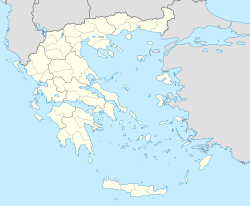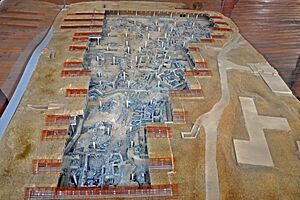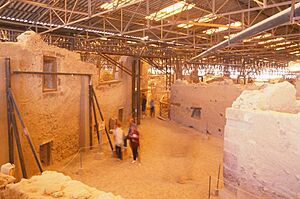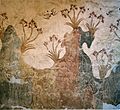Akrotiri (prehistoric city) facts for kids

Excavation of Akrotiri in 2018
|
|
| Location | Santorini, Greece |
|---|---|
| Region | Aegean sea |
| Coordinates | 36°21′05″N 25°24′13″E / 36.35139°N 25.40361°E |
| Type | Settlement |
| History | |
| Founded | c. 5000–4001 BCE |
| Abandoned | 16th century BCE |
| Cultures | Cycladic |
| Events | Theran eruption |
| Site notes | |
| Excavation dates | since 1967 |
| Condition | Ruins |

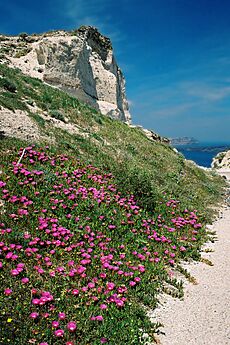
Akrotiri (pronounced ak-ro-TEE-ree) is an amazing ancient city on the Greek island of Santorini. It was once a busy Bronze Age settlement, part of the Cycladic Culture.
Around the 16th century BCE, a huge volcano erupted on Santorini. This event, called the Minoan eruption, buried Akrotiri under thick layers of volcanic ash. This ash acted like a time capsule, preserving the city's buildings, beautiful wall paintings (frescoes), and many everyday objects. Because of this, Akrotiri is often called the "Pompeii of the Aegean Sea." Archaeologists have been digging here since 1967, uncovering its secrets.
Contents
Akrotiri's Ancient Story
The first people lived in Akrotiri as early as 5,000 BCE. It started as a small village where people fished and farmed. Over time, it grew much bigger.
Akrotiri became an important trading center because of its location. It was on a main sea route between Cyprus and Minoan Crete. This made it a key spot for trading copper. People in Akrotiri even processed copper, as shown by the molds and tools found there.
The city became very advanced. It had paved streets, a complex drainage system, and people made high-quality pottery. This prosperity lasted for about 500 years.
However, everything changed in the 16th century BCE when the volcano on Thera (Santorini's ancient name) erupted. The exact year is not known, but it was a massive event that ended Akrotiri's time.
Life in the Cycladic City
Akrotiri was a settlement of the Cycladic culture, which was a group of islands in the Aegean Sea. It also had strong connections with the Minoan civilization from Crete. This is clear from the writing found there and the similar styles of art and objects.
Because the city was buried so quickly by volcanic ash, it is incredibly well-preserved. Just like the Roman city of Pompeii, archaeologists have found frescoes (wall paintings), pottery, furniture, advanced drainage systems, and even buildings that were three stories high!
Uncovering the Past
People first started digging on Santorini in 1867. But the big, modern excavation of Akrotiri began in 1967, led by a Greek archaeologist named Spyridon Marinatos. He quickly found the remains of the buried city.
Marinatos and his team built special workshops and labs at the site. This allowed them to store, repair, and study the ancient finds properly. Since many buildings were preserved to more than one story, digging was a unique challenge.
After Marinatos passed away in 1975, Christos Doumas took over the excavations.
Most of the amazing objects found at Akrotiri are now displayed in the Museum of Prehistoric Thera, which is not far from the site. It's interesting to note that only one small gold object has been found, and no human remains. This suggests that the people of Akrotiri had enough warning to leave the city safely before the eruption.
In 2005, a new roof built to protect the site sadly collapsed, causing one death. The site was closed for several years but the ancient ruins were not damaged. It reopened to visitors in 2012.
Amazing Wall Paintings
The frescoes (wall paintings) found in Akrotiri are very important. They are much better preserved than most other ancient paintings from the Minoan period, which usually only survive in tiny pieces.
The artists at Akrotiri used natural mineral pigments for their paints. This is why the colors, like white, yellow, red, blue, and black, have lasted so well. The painters started their work while the plaster was wet, but they didn't always keep it wet. This means some paint soaked in, while other parts can flake off.
When archaeologists first found these well-preserved frescoes, they needed special ways to protect them. A famous restorer named Tassos Margaritoff helped with this important work.
Some famous frescoes include:
- The Spring Fresco, which shows beautiful spring flowers and swallows.
- The Blue Monkeys fresco, showing monkeys climbing on rocks that look like the volcanic landscape of Santorini.
- The Fisherman and the Lady from the House of Ladies frescoes, which show people from ancient Akrotiri.
Everyday Objects from Akrotiri
Archaeologists have found many different kinds of artifacts at Akrotiri, especially pottery. Pottery is very useful for understanding ancient societies because it lasts a long time and was used for many things.
Since the people of Akrotiri left suddenly, they could only take their most valuable items. This means they left behind many everyday objects, giving us a great look into their lives.
Pottery served many purposes:
- Large jars were used to store goods.
- Stirrup jars were designed to transport things.
- There were also pots for cooking, eating, and drinking.
- Other items included bathtubs, oil lamps, and even beehives!
The shape and size of the pottery often tell us how it was used.
Besides pottery, archaeologists found "negatives" of wooden furniture. The volcanic ash filled the houses and created perfect molds of wooden objects that later decayed. By pouring liquid plaster into these molds, archaeologists could create casts of beds, tables, chairs, and stools! One common find is the "offering table," which had three decorated legs and a flat top.
Connecting Path
There is a path that goes from the modern village of Akrotiri down to the ancient excavation site. This path was reopened in 2012 and is kept in good condition by local people and international volunteers. It's a great way to walk or even mountain bike between the village and the ancient ruins.
Images for kids
See also
- Castle of Akrotiri, a ruined castle in Akrotiri, Santorini
- Akrotiri, Santorini, a village located north of the ancient settlement
- Summer Lovers, a 1982 Randal Kleiser film with filmed scenes at Akrotiri
- Akrotiri Boxer Frescoes, one of the frescoes at Akrotiri
- List of Aegean Frescoes


